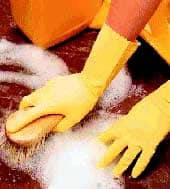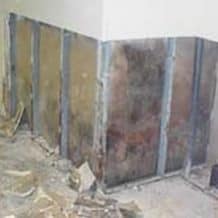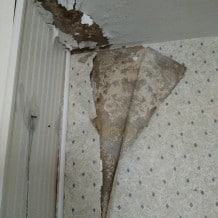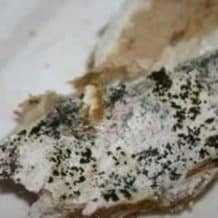Mold Cleaning Tips

The first step in solving an indoor mold problem is stopping the source of moisture. Next is to remove the mold growth. Here are the most common remedies for small occurrences of mold.
Sunlight
Ventilation
Use non-porous building materials
Household cleansers and/or bleach
Image: Protect yourself with gloves and mask when cleaning away mold.
If mold is growing in your home, you need to clean up the mold and fix the moisture problem. Mold growth can be removed from hard surfaces with commercial products, soap and water, or a bleach solution of 1 cup of bleach in 1 gallon of water. (This is for common mold or mildew, NOT toxic mold! In order to determine what type of mold you have, it is strongly advised to first have the proper sampling and laboratory testing performed by a qualified company before cleaning mold yourself.)
Warning: Never mix chlorine bleach solution with other cleaning solutions or detergents that contain ammonia because toxic fumes can be produced, making the cure worse than the problem.
Open windows and doors to provide fresh air.
If you plan to be inside the building for a while or you plan to clean up mold, you should buy an N95 mask at your local home supply store and wear it while in the building. Make certain that you follow instructions on the package for fitting the mask tightly to your face. If you go back into the building for a short time and are not cleaning up mold, you do not need to wear an N95 mask.
If the area to be cleaned is more than 10 square feet, consult the U.S. Environmental Protection Agency (EPA) guide titled Mold Remediation in Schools and Commercial Buildings. Although focused on schools and commercial buildings, this document also applies to other building types. You can get it free by calling the EPA Indoor Air Quality Information Clearinghouse at (800) 438-4318, or by going to the EPA web site at https://www.epa.gov/mold.
Always follow the manufacturer’s instructions when using bleach or any other cleaning product. Remember to protect your hands, eyes and lungs using rubber gloves, eye wear and a mask.
It is usually recommended that larger areas of 10 sq. ft. or more should be removed by a professional in mold cleanup. If possible, discard any building materials saturated by the water or already having visible mold growth.
Who should ask for microbial air testing?
Those who suspect a mold infestation – The Mold Patrol Testing Unit should be contacted if you suspect that you may have a problem with mold in your home or building.
All home owners and potential home buyers should be interested to know what kind of indoor air quality is in place.
Offices, schools, cottages, hospitals, clinics, gyms and other indoor area should be tested for mold problems.
Precautionary Measure – Whether or not you are aware of a mold problem in your home or building, air testing can be performed as a precautionary measure. Leave the Investigating to the professionals. Disturbance of a mold infested area can lead to a release of spores into the air that can cause serious illnesses.
“Now is the time to find out, before the occupants become sick.”
Resource: Printable Version of a Brief Guide to Mold, Moisture and Your Home
Next: Mold Prevention Tips
read more








